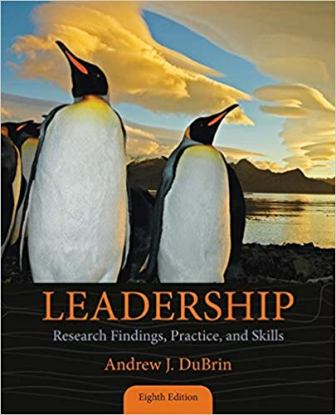This is completed downloadable of Test Bank for Leadership: Research Findings, Practice, and Skills, 8th Edition Andrew J. DuBrin

Product Details:
- ISBN-10 : 1285866363
- ISBN-13 : 978-1285866369
- Author: Andrew J. DuBrin
This book is a standalone book and will not include any access codes. The eighth edition of LEADERSHIP helps you understand leadership principles and hone your own leadership skills through a thoughtful balance of essential theory and real-world applications. The text provides a strong practical foundation by introducing leaders you can relate to and reinforcing your knowledge with frequent skill-building activities. Key updates include new opening vignettes and end-of-chapter cases, numerous additional skill-building exercises, and new research findings presented in each chapter.
Table of Content:
- Ch 1: The Nature and Importance of Leadership
- Ch 1: Learning Objectives
- Ch 1: Chapter Outline
- Ch 1: Introduction
- The Meaning of Leadership
- The Impact of Leadership on Organizational Performance
- Leadership Roles
- The Satisfactions and Frustrations of Being a Leader
- A Framework for Understanding Leadership
- Skill Development in Leadership
- Followership: Being an Effective Group Member
- Ch 1: Summary
- Ch 1: Key Terms
- Ch 1: Guidelines for Action and Skill Development
- Ch 1: Notes
- Ch 2: Traits, Motives, and Characteristics of Leaders
- Ch 2: Learning Objectives
- Ch 2: Chapter Outline
- Ch 2: Introduction
- Personality Traits of Effective Leaders
- Leadership Motives
- Cognitive Factors and Leadership
- The Influence of Heredity and Environment on Leadership
- The Strengths and Limitations of the Trait Approach
- Ch 2: Summary
- Ch 2: Key Terms
- Ch 2: Guidelines for Action and Skill Development
- Ch 2: Notes
- Ch 3: Charismatic and Transformational Leadership
- Ch 3: Learning Objectives
- Ch 3: Chapter Outline
- Ch 3: Introduction
- The Meanings of Charisma
- Three Types of Charismatic Leaders
- Characteristics of Charismatic Leaders
- The Vision Component of Charismatic Leadership
- The Communication Style of Charismatic Leaders
- The Development of Charisma
- Transformational Leadership
- Concerns about Charismatic Leadership
- Ch 3: Summary
- Ch 3: Key Terms
- Ch 3: Guidelines for Action and Skill Development
- Ch 3: Notes
- Ch 4: Leadership Behaviors, Attitudes, and Styles
- Ch 4: Learning Objectives
- Ch 4: Chapter Outline
- Ch 4: Introduction
- The Classic Dimensions of Consideration and Initiating Structure
- Task-Related Attitudes and Behaviors
- Relationship-Oriented Attitudes and Behaviors
- 360-Degree Feedback for Fine-Tuning a Leadership Approach
- Leadership Styles
- Ch 4: Summary
- Ch 4: Key Terms
- Ch 4: Guidelines for Action and Skill Development
- Ch 4: Notes
- Ch 5: Contingency and Situational Leadership
- Ch 5: Learning Objectives
- Ch 5: Chapter Outline
- Ch 5: Introduction
- Situational Influences on Effective Leadership Behavior
- Fiedler’s Contingency Theory of Leadership Effectiveness
- The Path-Goal Theory of Leadership Effectiveness
- Situational Leadership® II (SLII)
- The Normative Decision Model
- Leader–Member Exchange (LMX) and Contingency Theory
- Leadership During a Crisis
- Evidence-Based Leadership for the Contingencyand Situational Approach
- Ch 5: Key Terms
- Ch 5: Guidelines for Action and Skill Development
- Ch 5: Notes
- Ch 6: Leadership Ethics and Social Responsibility
- Ch 6: Learning Objectives
- Ch 6: Chapter Outline
- Ch 6: Introduction
- Principles and Practices of Ethical and Moral Leadership
- Guidelines for Evaluating the Ethics of a Decision
- A Sampling of Unethical Leadership Behaviors
- Leadership, Social Responsibility, and Creating an Ethical Organizational Culture
- Ethical and Socially Responsible Behavior and Organizational Performance
- Ch 6: Summary
- Ch 6: Key Terms
- Ch 6: Guidelines for Action and Skill Development
- Ch 6: Notes
- Ch 7: Power, Politics, and Leadership
- Ch 7: Learning Objectives
- Ch 7: Chapter Outline
- Ch 7: Introduction
- Sources and Types of Power
- Tactics for Becoming an Empowering Leader
- Factors that Contribute to Organizational Politics
- Political Tactics and Strategies
- Exercising Control over Dysfunctional Politics
- Ch 7: Summary
- Ch 7: Key Terms
- Ch 7: Guidelines for Action and Skill Development
- Ch 7: Notes
- Ch 8: Influence Tactics of Leaders
- Ch 8: Learning Objectives
- Ch 8: Chapter Outline
- Ch 8: Introduction
- A Model of Power and Influence
- Description and Explanation of Influence Tactics
- Leadership Influence for Organizational Change
- Relative Effectiveness and Sequencing of Influence Tactics
- Implicit Leadership Theories and Leadership Influence
- Ch 8: Summary
- Ch 8: Key Terms
- Ch 8: Guidelines for Action and Skill Development
- Ch 8: Notes
- Ch 9: Developing Teamwork
- Ch 9: Learning Objectives
- Ch 9: Chapter Outline
- Ch 9: Introduction
- The Leader’s Role in the Team-Based Organization
- Leader Actions That Foster Teamwork
- Offsite Training and Team Development
- The Leader–Member Exchange Model and Teamwork
- Ch 9: Summary
- Ch 9: Key Terms
- Ch 9: Guidelines for Action and Skill Development
- Ch 9: Notes
- Ch 10: Motivation and Coaching Skills
- Ch 10: Learning Objectives
- Ch 10: Chapter Outline
- Ch 10: Introduction
- Leadership and Employee Engagement
- Expectancy Theory and Motivational Skills
- Goal Theory
- Using Recognition and Pride to Motivate Others
- Coaching as an Approach to Motivation
- Coaching Skills and Techniques
- Executive Coaching and Leadership Effectiveness
- Ch 10: Summary
- Ch 10: Key Terms
- Ch 10: Guidelines for Action and Skill Development
- Ch 10: Notes
- Ch 11: Creativity, Innovation, and Leadership
- Ch 11: Learning Objectives
- Ch 11: Chapter Outline
- Ch 11: Introduction
- Steps in the Creative Process
- Characteristics of Creative Leaders
- Overcoming Traditional Thinking as a Creativity Strategy
- Organizational Methods to Enhance Creativity
- Self-Help Techniques to Enhance Creative Problem Solving
- Establishing a Climate and Culture for Creative Thinking
- Additional Leadership Practices That Enhance Innovation
- Ch 11: Summary
- Ch 11: Key Terms
- Ch 11: Guidelines for Action and Skill Development
- Ch 11: Notes
- Ch 12: Communication and Conflict Resolution Skills
- Ch 12: Learning Objectives
- Ch 12: Chapter Outline
- Ch 12: Introduction
- Communication Networks for Leaders
- Inspirational and Powerful Communication
- Listening as a Leadership Skill
- Overcoming Cross-Cultural Communication Barriers
- The Leader’s Role in Resolving Conflict and Negotiating Leaders
- Ch 12: Summary
- Ch 12: Key Terms
- Ch 12: Notes
- Ch 13: Strategic Leadership and Knowledge Management
- Ch 13: Learning Objectives
- Ch 13: Chapter Outline
- Ch 13: Introduction
- The Nature of Strategic Leadership
- Conducting a SWOT Analysis
- A Sampling of Business Strategies Formulated by Leaders
- Knowledge Management and the Learning Organization
- Ch 13: Summary
- Ch 13: Key Terms
- Ch 13: Guidelines for Action and Skill Development
- Ch 13: Notes
- Ch 14: International and Culturally Diverse Aspects of Leadership
- Ch 14: Learning Objectives
- Ch 14: Chapter Outline
- Ch 14: Introduction
- The Advantages of Managing for Diversity
- Cultural Factors Influencing Leadership Practice
- Cultural Sensitivity and Cultural Intelligence
- Global Leadership Skills
- Leadership Initiatives for Achieving Cultural Diversity
- Ch 14: Summary
- Ch 14: Key Terms
- Ch 14: Guidelines for Action and Skill Development
- Ch 14: Notes
- Ch 15: Leadership Development and Succession
- Ch 15: Learning Objectives
- Ch 15: Chapter Outline
- Ch 15: Introduction
- Development Through Self-Awareness and Self-Discipline
- Development Through Education, Experience, and Mentoring
- Leadership Development Programs
- Leadership Succession
- Challenges of Being a New Leader
- Ch 15: Summary
- Ch 15: Key Terms
- Ch 15: Guidelines for Action and Skill Development
- Ch 15: Notes
- Glossary
- Name Index
- Company Index
- Subject Index





